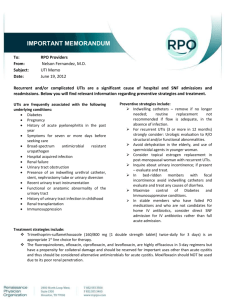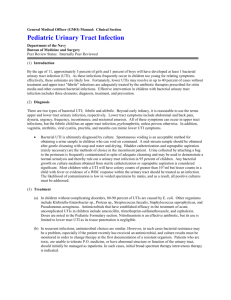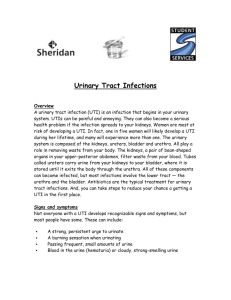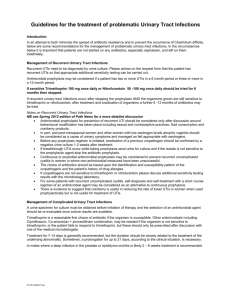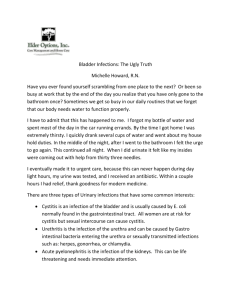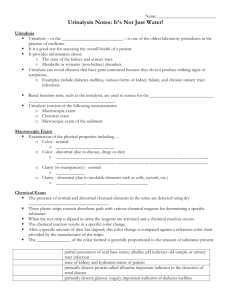Urinary Tract Infections: A Common Occurrence A urinary tract
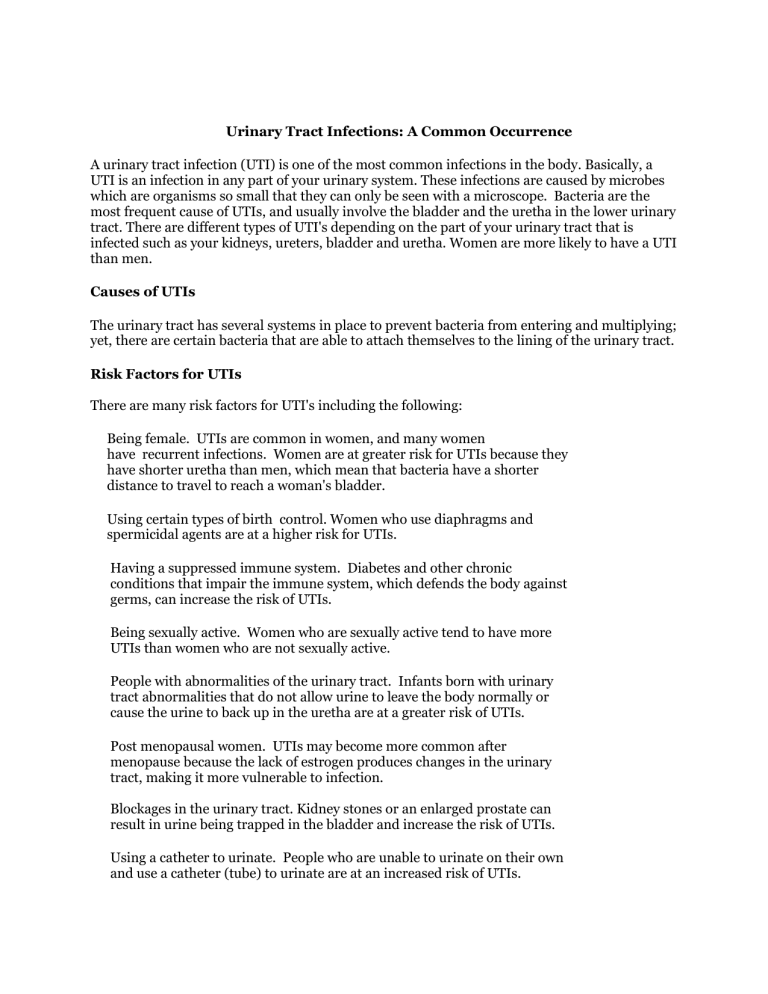
Urinary Tract Infections: A Common Occurrence
A urinary tract infection (UTI) is one of the most common infections in the body. Basically, a
UTI is an infection in any part of your urinary system. These infections are caused by microbes which are organisms so small that they can only be seen with a microscope. Bacteria are the most frequent cause of UTIs, and usually involve the bladder and the uretha in the lower urinary tract. There are different types of UTI's depending on the part of your urinary tract that is infected such as your kidneys, ureters, bladder and uretha. Women are more likely to have a UTI than men.
Causes of UTIs
The urinary tract has several systems in place to prevent bacteria from entering and multiplying; yet, there are certain bacteria that are able to attach themselves to the lining of the urinary tract.
Risk Factors for UTIs
There are many risk factors for UTI's including the following:
Being female. UTIs are common in women, and many women
have recurrent infections. Women are at greater risk for UTIs because they
have shorter uretha than men, which mean that bacteria have a shorter
distance to travel to reach a woman's bladder.
Using certain types of birth control. Women who use diaphragms and
spermicidal agents are at a higher risk for UTIs.
Having a suppressed immune system. Diabetes and other chronic
conditions that impair the immune system, which defends the body against
germs, can increase the risk of UTIs.
Being sexually active. Women who are sexually active tend to have more
UTIs than women who are not sexually active.
People with abnormalities of the urinary tract. Infants born with urinary
tract abnormalities that do not allow urine to leave the body normally or
cause the urine to back up in the uretha are at a greater risk of UTIs.
Post menopausal women. UTIs may become more common after
menopause because the lack of estrogen produces changes in the urinary
tract, making it more vulnerable to infection.
Blockages in the urinary tract. Kidney stones or an enlarged prostate can
result in urine being trapped in the bladder and increase the risk of UTIs.
Using a catheter to urinate. People who are unable to urinate on their own
and use a catheter (tube) to urinate are at an increased risk of UTIs.
Symptoms
There are not always symptoms of urinary tract infections, and UTIs in older adults may be overlooked or mistaken for other health conditions. The symptoms that are usually associated with urinary tract infections may include the following:
A strong and intense urge to urinate
A burning, painful feeling when urinating
Frequently passing small amounts of urine
Urine that may appear cloudy, dark or red, indicating a sign of blood in
the urine
Strong smelling urine
Rectal pain in men
Pelvic pain in women
Fever, shaking and chills, nausea, vomiting and upper back and side pain
may mean that the kidneys are affected and a fever may also mean that
the infection is in the prostate.
Diagnosis
The health care provider will ask about the symptoms the person is experiencing and test a urine sample. When people have recurring urinary tract infections the urine is cultured, or placed in a tube or dish which generally takes 1-3 days to see what bacteria is present for the purpose of treating the infection. There are also other tests that the doctor may order for people with recurrent urinary tract infections.
Treatment
Urinary tract infections that occur in a healthy person, who does not have an obstructed urinary tract, is said to have an uncomplicated UTI, is usually prescribed antibiotics and encouraged to drink lots of fluids, unless they are in kidney failure, and to urinate fequently. Doctors specify the quantity of liquids that should be consumed by people with UTIs who are in renal failure. A follow-up urinalysis can confirm that there is no longer an infection of the urinary tract. There are several treatments that doctors use for people, usually women, with recurrent UTIs.
If you have symptoms of a urinary tract infection it is important that you see your health care provider.
References
"Urinary Tract Infection." Mayo Clinic. August 10, 2012.
"Urinary Tract Infections in Adults." The National Kidney and Urologic Diseases Information
Clearinghouse (NKUDIC). National Institute of Health. May 24, 2012.
